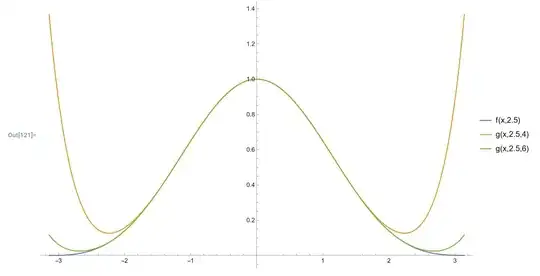We start with the power series expansion of the sinc function given by
$$
\operatorname{sinc}x=\frac{\sin x}{x}=\sum_{k=0}^\infty\frac{(-1)^k}{(2k+1)!}x^{2k}.
$$
To obtain a series expansion for powers of the sinc function we may use this formula to write
$$
\tag{1}
\operatorname{sinc}^ax=\sum_{m=0}^\infty c_m x^{2m},
$$
where $c_0=1$ and the higher-order coefficients obey the recursive relation
$$
c_m=\frac{1}{m}\sum_{k=1}^m(ka-m+k)\frac{(-1)^k}{(2k+1)!}c_{m-k}.
$$
The series expansion given by $(1)$ has been tested for integer and noninteger values of $a$ on the interval $(-\pi,\pi)$. For $a\in\Bbb N$ this expansion should converge on all of $\Bbb R$.
To implement in Mathematica we may define the coefficients $c_m$ as follows:
f[x_, a_] := Sinc[x]^a;
c[0, a_] := 1;
c[m_, a_] := 1/m Sum[(k a - m + k) (-1)^k/(2 k + 1)! c[m - k, a], {k, 1, m}];
g[x_, a_, M_] := Sum[c[m, a] x^(2 m), {m, 0, M}];
As an example, here is a plot comparing $f(x,a)=\operatorname{sinc}^ax$ to the series expansion $g(x,a,M)$ for $a=2.5$ and $M=4,6$ showing the expansion converging to the target function as the number of terms increases.

Finally, here is a table of the first eleven coefficients $c_m$:
$$
\left(
\begin{array}{cc}
m & c_m \\
0 & 1 \\
1 & -\frac{a}{6} \\
2 & \frac{1}{360} a (5 a-2) \\
3 & -\frac{a (7 a (5 a-6)+16)}{45360} \\
4 & \frac{a (5 a-4) (7 a (5 a-8)+36)}{5443200} \\
5 & -\frac{a (11 (a-2) a (35 (a-2) a+104)+768)}{359251200} \\
6 & \frac{a (13 a (77 a (5 a (35 (a-6) a+572)-4248)+255968)-1061376)}{5884534656000} \\
7 & -\frac{a (a (13 a (77 a (5 a (a (5 a-42)+164)-1848)+190112)-1810176)+552960)}{35307207936000} \\
8 & \frac{a (17 a (a (13 a (385 a (5 a (a (5 a-56)+296)-4672)+3586192)-57567616)+39964416)-200005632)}{144053408378880000} \\
9 & -\frac{a (19 a (17 a (7 a (13 a (385 a (a (5 a (5 a-72)+2472)-10368)+10994448)-260572032)+2116182272)-23881992192)+129369047040)}{1034591578977116160000} \\
10 & \frac{a (a (209 a (17 a (7 a (325 a (55 a (a (35 (a-18) a+5448)-29232)+5815248)-4716438048)+56126325760)-1051637137920)+140441050828800)-38930128699392)}{3414152210624483328000000} \\
\end{array}
\right)
$$
